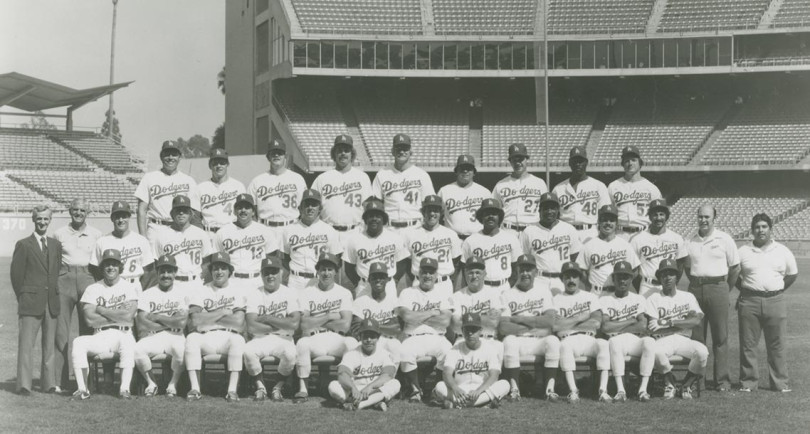
Feature
1981 World Championship Season “Super Dodger Comeback Team”
By Robert Schweppe
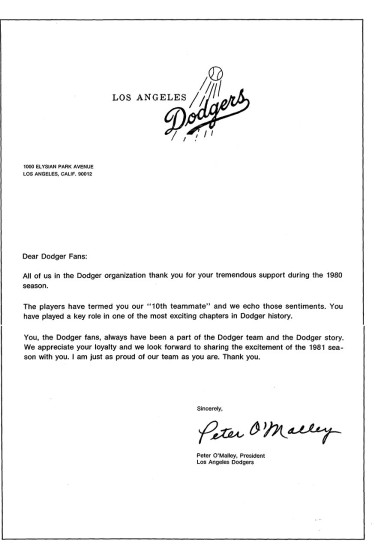
On October 7, 1980, Dodger President Peter O’Malley writes a letter to Dodger fans after the Dodgers lost a one-game playoff to the Houston Astros in Game 163 of the regular season to determine the National League West Division champion. In his letter, which appeared in Los Angeles area newspapers, he expresses appreciation to Dodger fans as the “10th teammate” and states, “we look forward to sharing the excitement of the 1981 season with you.”
On the morning of October 7, 1980, Dodger fans woke up to their morning newspaper mourning the 7-1 loss to the Houston Astros in the one game playoff for the National League Western Division title. The Los Angeles Dodgers took out a full page ad in local newspapers that simulated official Dodger stationery. In a letter, Dodger President Peter O’Malley thanked all Dodger fans for being the “Tenth Man” in the lineup. He concluded his statement, “We appreciate your loyalty and we look forward to sharing the excitement of the 1981 season with you. I am just as proud of our team as you are.”
And what an exciting 1981 season it was.

The 1981 Opening Day would set the pace for the season. Fernando Valenzuela became the first Dodger rookie pitcher to throw a shutout on Opening Day to stop the Houston Astros, 2-0.
But, after a great start, the Dodgers slowed and the Cincinnati Reds crawled within a 1/2 game of first place. But, an interruption of play was looming on the horizon. The season ended for the time being on June 12th because of labor issues. And baseball stopped playing in the major leagues.
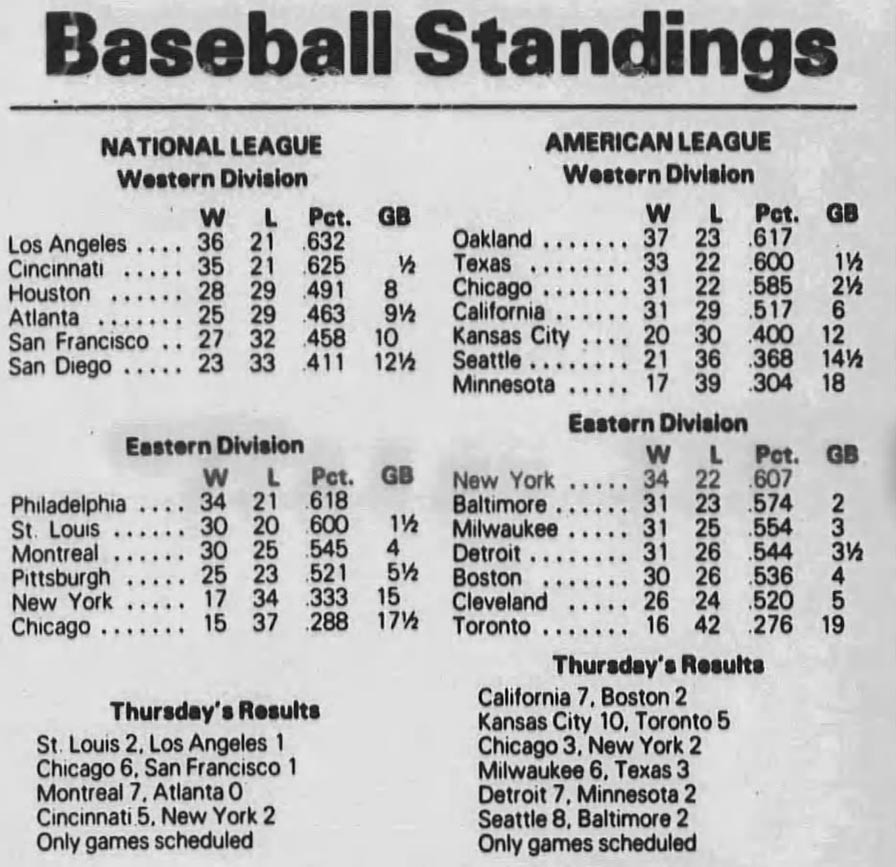

August saw a labor settlement and the resumption of play. However, because of the lengthy stoppage of schedule, the major league clubs agreed to a compromise that the teams in first place on June 12th automatically qualified for the playoffs. And it was the Dodgers who owned that 1/2 game lead in first place over the Reds.
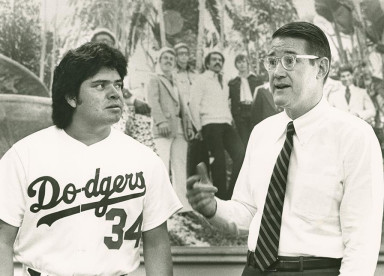
In May, 1981, Fernando Valenzuela, No. 34, is with Peter O’Malley, President, Los Angeles Dodgers. Fernando’s rookie season had just taken off and was the start of “Fernandomania” in the U.S. and his native Mexico. Fernando would win an important Game 3 of the 1981 World Series at Dodger Stadium when the Dodgers had a 2-0 deficit. The Dodgers would win the next three games to clinch the World Championship.
Dodger Manager Tom Lasorda could see ahead to the future. He knew with three rounds of post-season play, the October schedule would be harder than ever before. He would need his bench to be as ready as possible to make important contributions.

The National League Western Division Championship opened exactly 365 days after the last time the Dodgers and Astros had met for the 1980 Western Division title. In the 10th inning, the Astros’ Alan Ashby hit a two-run home run for the 3-1 walk-off win. The Astros led the series, 1-0. Game 2 was bad deja vu in the sense for the Dodgers. The Dodgers finished the game g oing 0 for 9 with men in scoring position, and that’s how they ended the game, with 0 runs. The Astros won 1-0, and the Dodgers were coming to Los Angeles for Game 3, down 2-0 in the best three-of-five series.
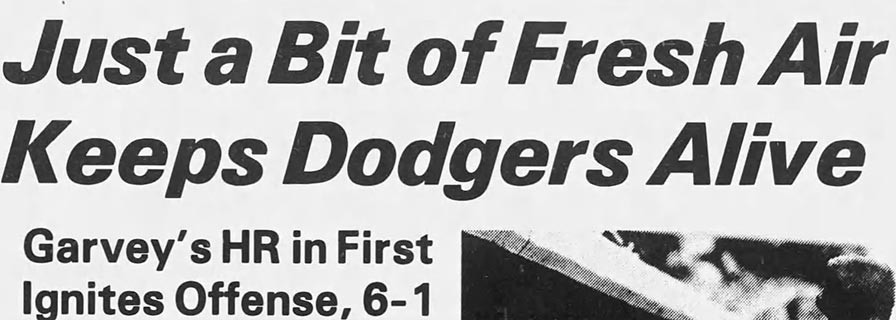
Before Game 3 with Houston, Lasorda spoke to his team in a closed-door meeting. After the win, he told Mark Heisler of the Los Angeles Times, “I told them I believed more than anything in my life we were going to win and I wanted them to feel the same way.” Starting pitcher Burt Hooton would right the ship with 7 1/3 innings, allowing one run. Steve Garvey hit a two-run home run in the first inning and the Dodgers won Game 3, 6-1.
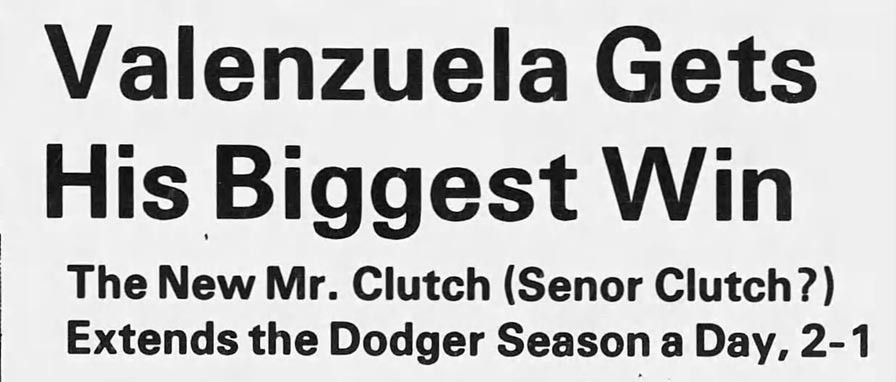
Fernando Valenzuela would start for the Dodgers in Game 4 of the National League Division Series and face Vern Ruhle. Reporter Heisler of the Los Angeles Times, who had covered the Dodgers all season, called the game pitched by Valenzuela, “One of his better games.” The Dodgers won 2-1, and the series was tied, 2-2, and a decider to be played Sunday.

Game 5 was winner-take-all for the Western Division. Jerry Reuss was ready for the start to face Nolan Ryan and the Astros. Reuss wrote in his autobiography, “Bring In the Right Hander!” that “adrenaline more than compensated for pitching on short notice.” Instead of needing 15 minutes to warm up for a start, Reuss said he was ready to start a game from a 10-minute warmup. The game was scoreless until the sixth inning. Dusty Baker walked and Garvey singled him to third base. Rick Monday, hit a two-strike pitch to single and score Baker for their first run and the Dodgers would pick up three runs in the inning. Reuss took care of the rest and shut out the Astros, 4-0. The Game 5 win of the 1981 Western Division Series now sends the club on to the National League Championship Series.
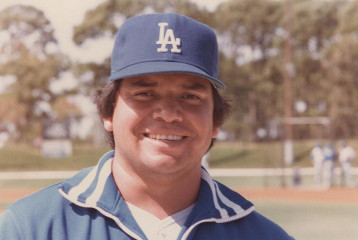
Fernando Valenzuela electrified baseball during the 1981 “Fernandomania” season. Selected as the 1981 Opening Day starter, he threw a shutout, becoming the first Dodger rookie pitcher to pitch one on Opening Day. He went on to win eight straight decisions, including five shutouts.
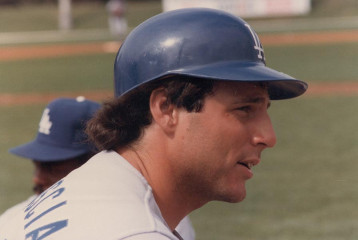
Mike Scioscia played catcher for the Dodgers from 1980-1992, was a two-time National League All-Star and a member of two World Championship Dodger teams (1981 and 1988). He was considered one of the top catchers in the game for his ability to work with pitchers and call games, as well as his defensive prowess. He was the catcher for the Dodgers at the age of 22 when Fernando Valenzuela pitched his Opening Day shutout in 1981. He is a 1988 Dodger hero when he homered off the Mets in the ninth inning to tie the game at 4-all in Game 4 of the NLCS. Scioscia hit only eight home runs in 1988, but his two-run home run gave the Dodgers the chance to win the game, 5-4 in the 12th inning.
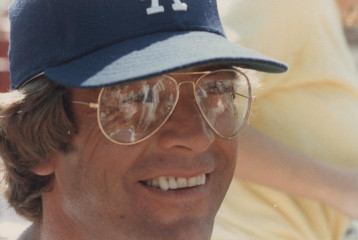
Catcher Steve Yeager, who had a superior throwing arm, played 14 of his 15 major league seasons with the Dodgers and was a tri-MVP in the 1981 World Series with Ron Cey and Pedro Guerrero.
1981 NATIONAL LEAGUE CHAMPIONSHIP SERIES

The two competing teams for the National League entry to the World Series, the Montreal Expos and the Dodgers had one day off after a grueling opening series to play an even more grueling series. In Game 1, Hooton shut out the Expos for 7 1/3 innings and the Dodger pitching staff had not allowed a run for 17 straight innings. Heisler asked Lasorda if the Dodger starting pitchers were at their peak. Lasorda’s reply, “I hope not.” Even though they had a 1-0 lead in the series and Valenzuela on the mound for the Dodgers in Game 2, the Expos undid all that with a 3-0 win to tie the series.
And on everyone’s mind, well, the Expos anyway, was the weather in Montreal for the final three games. The Expos played it up in Los Angeles. Expo catcher Gary Carter told the Los Angeles Times, “Bring your long underwear because it’s going to be cold.” Lasorda responded to the challenge. In his autobiography, “The Artful Dodger,” he said his response to the question of a weather disadvantage to his team was, “Only if it snows on our side of the field and not theirs.” A three-run home run by the Expos’ Jerry White pushed the Expos to a 4-1 Game 3 win and a 2-1 series lead. Dodger Manager Tom Lasorda, meeting with the media after the loss that had his team down 2-1 in the LCS and on the road, still believing in his club, predicted, “They (the Expos) have another game to win tomorrow and they’re not going to win!”
On Saturday morning, the Dodger players received a cold wakeup call of their season and it had to do with their luggage. Players are required to have their luggage downstairs in the lobby so it can be picked up and kept with the team. If the team should lose. It was Hooton who again rose to the occasion for the third time in the playoffs. He kept the Dodgers in the game until Garvey hit a two-run home run to break the 1-1 tie en route to a 7-1 Game 4 win. The game was Hooton’s second win of the LCS and he would later be named the LCS Most Valuable Player.

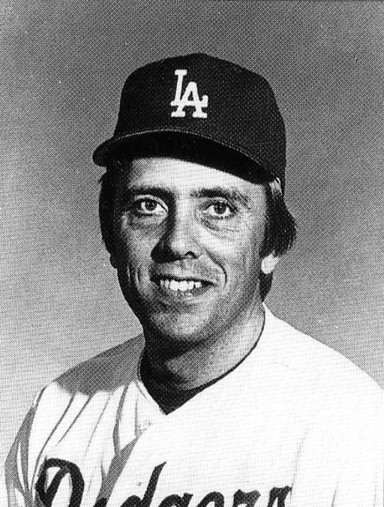
Dodger outfielder and NLCS hero Rick Monday was a major contributor in 1981.
On Monday, for Game 5 and the decider for which National League club goes to the World Series, NBC announcers Dick Enberg was with pitching great Tom Seaver providing commentary. As the broadcast opened, Enberg described the weather as “gray, cold, drizzly,” and the baseball fans, from Montreal and Los Angeles, were bundled up.
The Expos scored a run in the first inning. Lasorda had a Dodger pitcher warming up in the bullpen to be sure the game didn’t get away. From then on, Valenzuela kept the Dodgers in the game. After the first inning run, he did not allow another. He even drove in the Dodgers’ first run to tie the game on an infield out. The game was tied, 1-1 as they started the ninth inning.

With two outs and no one on base, Rick Monday came up. On a 3-1 count pitch, Monday swung and admitted, “I hit the ball and something that had never happened to me before. I lost the flight of the ball. I did not know where it was. I knew it was really high. I’m going to first base and I started to watch Andre Dawson moving over to right center and he keeps running and he kept going and I’m thinking, ‘It’s hit so high it’s probably going to be caught.’” Enberg, calling the game on national television as the 3-1 pitch came in said, “Hit to center….hit well…Dawson back…and Monday… will TOUCH ‘EM ALL!”, his signature home run call. The Dodgers had a lead for the first time in the game.
Valenzuela got the first two outs, then walked two Expo hitters. Lasorda went to Bob Welch for the final out. It was a fast save. On the first pitch, Davey Lopes fielded a ground ball hit to the right side and threw to Garvey who stretched for the final out before a hustling Jerry White down the line. Garvey caught the throw and raised his arms in triumph. The frustration of the 1979 season and the disappointment of the 1980 season evaporated. And the Dodgers were on their way to New York for a flight of approximately one hour and a whole different world than Montreal.
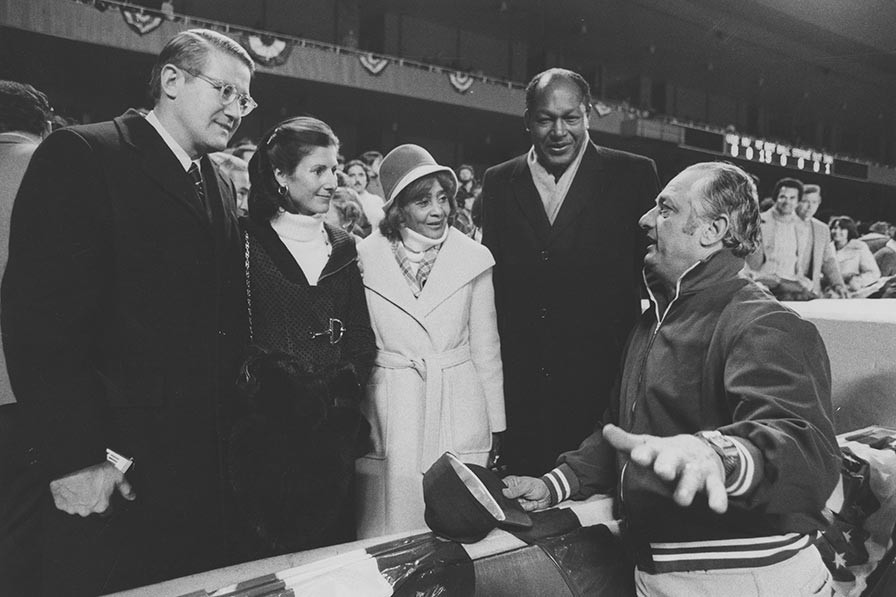
L-R: Dodger President Peter O’Malley; Annette O’Malley; Mrs. Ethel Bradley; Los Angeles Mayor Tom Bradley; Dodger Manager Tommy Lasorda. Dodger Manager Tommy Lasorda greets Peter and Annette and Mrs. Ethel Bradley and Los Angeles Mayor Tom Bradley at Yankee Stadium before the first game of the 1981 World Series between the Dodgers and New York Yankees.
1981 World Series
The loudest screams of joy when the Los Angeles Dodgers and the New York Yankees qualified for the 1981 World Series, other than the respective teams, was likely from the ABC-TV network, who would televise the World Series. Because both cities, the largest and second largest television markets in the United States, would likely provide a bonanza of good ratings in October.
In Game 1, Jerry Reuss started for the Dodgers and the Yankees were after him right away. A three-run home run by Bob Watson got the Yankees going en route to their 5-3 Game 1 win.
Game 2 at Yankee Stadium featured strong starting pitching from both teams, but the Yankees were just better and won 3-0. Burt Hooton allowed one unearned run in six innings and took the loss as the Dodgers had just four hits off two Yankee pitchers, one of them former Dodger Tommy John, the starting pitcher. The Yankees scored two runs in the eighth inning to put the game away.
The seven-game World Series can be won by a team that has lost the first two games of the Series, but it doesn’t happen often, only 11 times in the history of the World Series. The Dodgers had done that in 1955 in Brooklyn and in 1965 to defeat Minnesota.
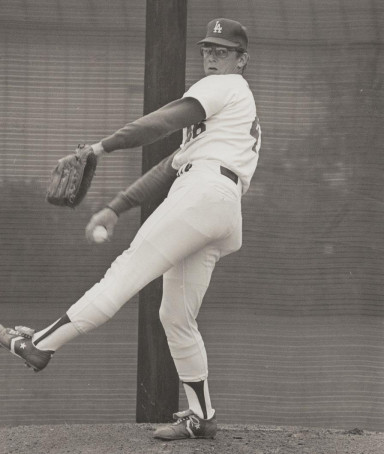
Consistent Dodger pitcher Burt Hooton was named the 1981 NLCS MVP for wins in Game 1 and Game 4. He also won Game 6 of the 1981 World Series that gave the Dodgers the World Championship.
The one positive note expressed even though the club was down 2-0 in the World Series was by the Dodger President. Los Angeles Times Bob Oates did a question and answer with Peter O’Malley on his past memories of the Dodgers in post-season, his particular memory of the 1981 season (O’Malley said, “I don’t know if anyone has had a more spectacular season than Fernando Valenzuela.”), an overview of the team’s baseball operation and a continued emphasis on the necessary player development that had been so successful through the years. At the end of the interview, on the day Game 3 of the 1981 World Series would be played, Oates asked, “So why can’t you beat the Yankees?” O’Malley’s answer, “We’ll beat the Yankees.”
Game 3 at Dodger Stadium was a virtual elimination game for the Dodgers, if not an actual one. Should the Yankees win Game 3, World Series history would have called it a lock as no team has ever won four straight World Series games after being down 3 games to none. Ron Cey got Fernando Valenzuela started with a three-run home run in the first inning. But Valenzuela’s wildness led to the Yankees to score runs and they led 4-3 by the fourth inning.
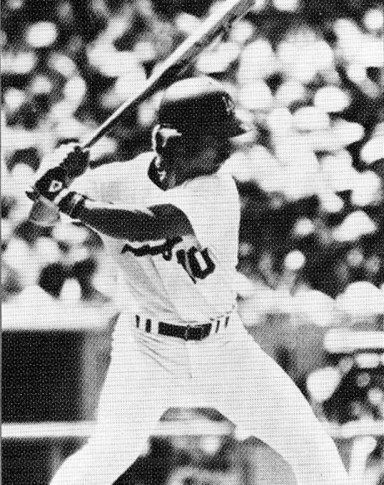
Ron Cey was a fixture for the Dodgers at third base providing solid defense and power for their offense. He was tri-MVP of the 1981 World Series with Steve Yeager and Pedro Guerrero.
The Dodgers rallied in the fifth inning to take the lead. Valenzuela was as tough as could be and held on for a 5-4 win. The unofficial count was 149 pitches thrown by him in nine innings, and the Dodgers had new life in the 1981 World Series with their first win. He had retired the Yankees six times with men in scoring position in the final 6.1 innings. The 5-4 win by Valenzuela was best said by the greatest sports broadcaster ever and ever will be, Vin Scully, that “Somehow, this was not the best Fernando game. It was his finest.”


Game 4 of the 1981 World Series between the Yankees and the Dodgers would take its own place in their storied history. With two outs in the ninth inning of Game 4, ABC-TV commentator Howard Cosell would say, “What a crazy game!” The game was a study in perseverance as each side went back and forth for nine innings.
The Yankees climbed out to an early lead. By the sixth inning, the Yankees led, 6-3.
Jay Johnstone was Lasorda’s top left-hand pinch-hitter but he had several starts in September and those at bats paid off. On a 1-2 count, with a man on base in the sixth inning, Johnstone got all of one pitch and homered into the right field pavilion. The Yankees had opened their lead in the top of the sixth and now the Dodgers had closed to within one run again. As Johnstone circled the bases, he recalled to author Jason Turbow, “That changes the whole game.” It changed enough that by the end of the seventh inning, the Dodgers led, 8-6.
With two on and two outs in the ninth inning, Dodger closer Steve Howe faced Willie Randolph of the Yankees. On a 1-1 pitch, Randolph drove the ball to right center field. Center fielder Derrel Thomas went back, back, back until he reached the warning track and then squared his shoulders to catch the final out, four steps from the center field fence. This time, the center fielder had just enough room to catch the final out of the game. And the World Series was now tied, two games apiece.
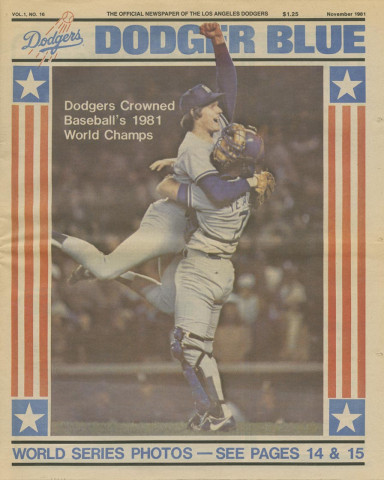
Dodger Blue, the Dodgers’ official publication, celebrated the 1981 World Championship season in its November, 1981 issue with a cover photo of the final out over the Yankees. Reliever Steve Howe’s arm is flung high and is being lifted by catcher Steve Yeager.
Reuss, the Dodgers’ Game 5 starter, was on the Dodger bench for Games 3 and 4 watching closely and making his own mental notes to incorporate a new game plan. He would stick with his fastball, keep the ball down, and attack the Yankees that way, even if they could expect what was coming. Catcher Steve Yeager told author Jason Turbow that in Game 5, “I don’t think he (Reuss) threw more than two or three curveballs.”

The Yankees held a 1-0 lead in the sixth inning and were not that many outs away from bringing in their closer, Rich Gossage. Pedro Guerrero found a pitch he liked and homered to tie the game. With the crowd still buzzing from the tying home run, and Steve Yeager coming to the plate with the score tied, Yankee Manager Bob Lemon now had to treat Game 5 as an elimination game and Gossage started to warm up in earnest. Yeager had home run power when he got his pitch, and when he got a fastball from Guidry, he homered into the left field pavilion for a 2-1 Dodger lead. Reuss kept the score as it was, and the Dodgers now led in the World Series, 3 games to 2.
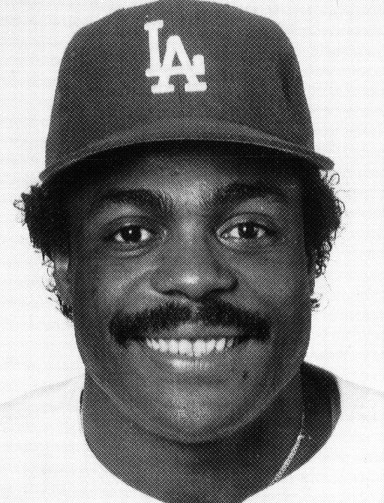
Pedro Guerrero was a 1981 World Series tri-MVP with Ron Cey and Steve Yeager. Guerrero, who played 11 seasons for the Dodgers, had three hits, including a home run and five RBI, in the clinching Game 6 win of the 1981 World Championship over the New York Yankees, 9-2.
The Dodgers had a very important person with them for Game 6, but the VIP wasn’t on the field playing. Mrs. Rachel Robinson, the widow of Jackie Robinson, attended the game as a guest of Peter O’Malley, and sat with his family and Mrs. Ethel Bradley, the wife of Los Angeles Mayor Tom Bradley. Rachel had been at Yankee Stadium 26 years earlier on October 4, 1955 when the Dodgers had defeated the Yankees, 2-0 for the franchise’s first World Championship.
Despite falling behind early, 1-0 for the fifth time in six games, the Dodgers again overcame their deficit. They didn’t stop scoring runs until the eighth inning when after the 10 o’clock hour in New York, Guerrero homered in the eighth inning for the Dodgers’ ninth and final run. The final outs of Game 6 came quietly, with virtually no drama, which came as much as of a surprise as anything, seeing how much tribulation the club had to go through to get there.
With so many players contributing to the World Championship, the Baseball Writers split the difference and awarded Tri-Most Valuable Players to Ron Cey, Pedro Guerrero, and Steve Yeager, the first time that had happened in World Series history.
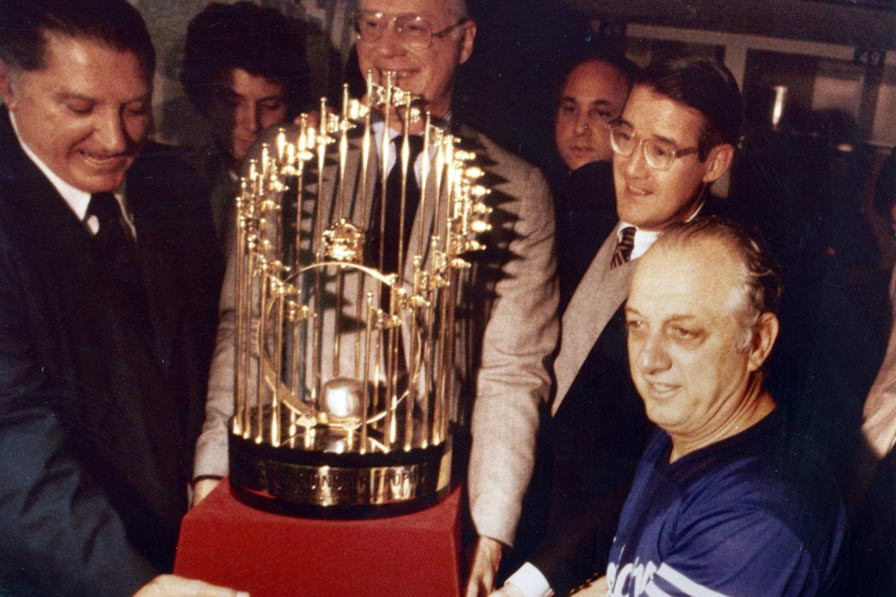
L-R: Al Campanis, Dodger General Manager; Bowie Kuhn, Baseball Commissioner; Peter O’Malley, Dodger President; and Tommy Lasorda, Manager of the Dodgers. October 28, 1981, Dodger clubhouse at Yankee Stadium, New York

In a celebratory Dodger clubhouse, Roger Angell of the New Yorker magazine spoke with Peter O’Malley. Angell wrote, “I congratulated him and he thanked me and said, ‘Yes, isn’t it wonderful? You wait and wait and then it comes. Do you know that this is the very same room that the 1955 Dodgers came back to after they’d beaten the Yankees for the very first time? It was the same for them – they won the Series away from home, like this, in the Stadium. Roy Campanella and Gil Hodges and Pee Wee and Johnny Podres and all the rest of them…I wasn’t here, but I’ve heard about it all my life, of course. I’ve been thinking about that team all day long.’”
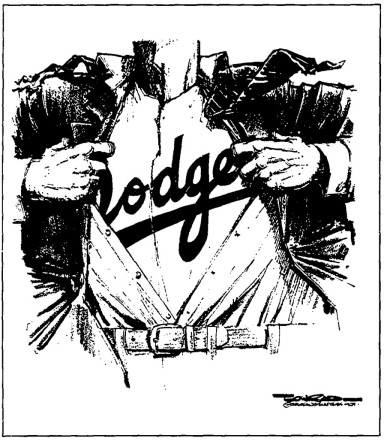
On October 27, 1981, Pulitzer Prize-winning editorial cartoonist Paul Conrad of the Los Angeles Times captures the moment perfectly after the Dodgers took three consecutive 1981 World Series games over the New York Yankees at Dodger Stadium. The Dodgers won their fifth World Championship one day later October 28, with a 9-2 victory over the Yankees at Yankee Stadium.
As happy Dodger fans opened their Los Angeles Times newspaper on the morning of October 27, on the editorial page was a cartoon by Pulitzer Prize-winning artist Paul Conrad. Whether you loved Conrad’s humor or loathed his politics, on this morning, he drew an image for the ages. He needed no words of explanation, but the message was clear as a bell. The cartoon had a man dressed clearly in a suit with a tie and shirt. The tie is loose, the shirt and jacket have been wrenched mightily aside to reveal a super-size chest. The visible image is to see a team name of a baseball uniform worn beneath the business clothes, written in the familiar Palmer script also known around the world, “Dodgers.”
Just like Superman.

